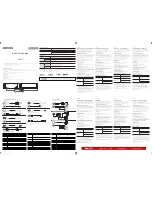
migra MPB EN TCP/IP
Large Format, Graphics Compatible Display with Ethernet Interface
Page 15
microSYST Systemelectronic GmbH, Am Gewerbepark 11, 92670 Windischeschenbach
+49 9681 91960-0,
+49 9681 91960-10, [email protected], www.microsyst.de
3.7 Description of the Data Unit for Online Frames
The display must be configured with the PC software (define character
sets, graphics, texts, variables and macros). The individual elements
included in the configuration which is downloaded to the display can
then be used by the frames described in this chapter.
The display is delivered with a pre-programmed default configuration.
However, you can create an individualised configuration for your own
application and download it to the display unit with the PC software. The
existing default configuration is overwritten during this process.
All indices are 0-b
ased, i.e. “000” is transmitted in order to query the first
text. The position 0 / 0 (X / Y) is the upper left-hand pixel at the display
unit. All variables, graphics and texts are written to the display starting at
the selected X and Y coordinates, and then proceed down and to the
right. The display’s physical limits may not be exceeded during this
process (otherwise no display appears).
Note: Text, variable, graphic, character set and bar graph indices in
the PC software and at the controlling are 0-based!
Frames which contain no online text (ASCII codes 20
h
through FF
h
, 10
h
and 13
h
), start with the escape character (1B
h
) as the first data byte.
If response frames are used, the next frame can be transmitted
immediately after receipt of the response. However, this may lead to
delays in the execution of macros, moving screen texts and scrolling if
the frame sequence is to fast.
If response telegrams are not used, a pause must be inserted between
the frames as described in chapter
“Online Frame Layout”.
Data bytes included in the data unit must be in ASCII format!
Example, Specifying Position:
... 31
h
32
h
33
h
... must be transmitted for position 123
D
!
(ASCII characters “1”, “2” and “3”).
Refer to chapter “Displayable Characters” for a table of displayable
ASCII characters!
















































